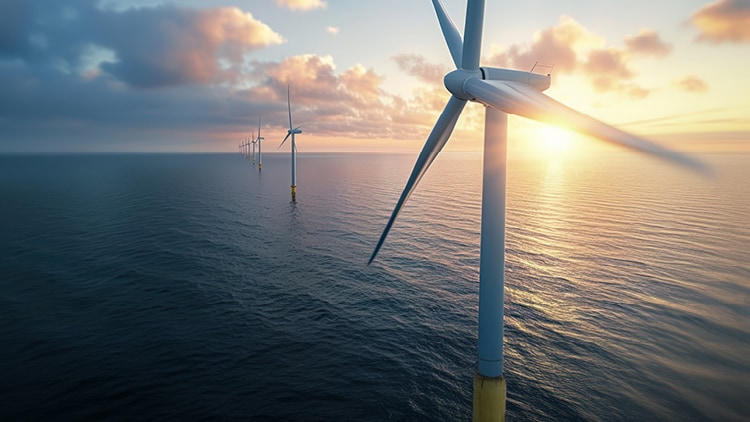Tax incentives and strategic investment key to growth
Ireland’s offshore wind sector will be pivotal to meeting our legally binding climate targets, addressing energy security concerns and ensuring Ireland remains attractive for foreign direct investment (FDI).
Ireland is fortunate with a maritime area more than seven times the size of its landmass. Combined with wind conditions and our location at the edge of the Atlantic Ocean, this presents a significant economic opportunity for:
generating renewable energy
interconnection
producing green hydrogen.
This is reflected in our ambition to deliver at least 5 GW of offshore wind and an additional 2 GW for non-grid connected offshore wind by 2030.
The window of time to 2030 is narrowing, and more ambitious targets are coming down the track under the Future Framework for Offshore Renewable Energy (20GW by 2040 and at least 37GW by 2050).
Urgent need to accelerate investment
We must speed up investment in this sector if we’re to make meaningful progress towards our climate targets and capitalise on the significant economic opportunity for Ireland.
This includes:
becoming a net exporter for electricity
producing green hydrogen for industry, heat and transport
continuing to attract new industry here.
This will create high skilled green jobs, drive innovation, attract and retain FDI, and give Ireland a more stable economic footing into the future. It will also help us achieve Net Zero and contribute to wider European decarbonisation.
The publication of Ireland’s Offshore Wind Industrial Strategy earlier this year is welcome. It focuses on:
offshore wind supply chains
research, development and innovation
future demand and end uses for renewable energy
balanced regional economic development opportunities.
Leaving aside the whole area of planning and permitting, there are other significant, but not insurmountable barriers to address if we’re to achieve our ambitions, including:
mobilising investment into our ports, grid and supply chain, and
addressing the skills shortage. This needs to be done in tandem with working alongside local communities, ensuring there is a social licence to operate and a just transition for all.
Putting the right policy frameworks in place now (including tax policy supports) will help to attract investment, supply chain and talent, and establish Ireland as a hub for innovation and FDI.

Ireland can learn from policies introduced in other countries (acknowledging some additional complexity here due to EU rules such as State Aid). Let’s look to Scotland, which has already established itself as a key player in offshore wind.
How Scotland has succeeded
Scotland is widely recognised as a world leader in offshore wind. It has a target to deliver 11GW of offshore wind by 2030.
Capacity in Scotland is now around 3 GW split across seven offshore wind farms. It can also draw on decades of experience in the North Sea.
Irish-Scottish collaboration on offshore wind
In June 2024, it was announced that Irish and Scottish Ministers would promote collaboration between Ireland and Scotland in harnessing the full economic development potential of offshore wind in both countries and beyond. In this, they will work with companies, researchers, and government departments and agencies in the offshore wind sector.
At the launch, Minister for the Environment, Climate and Communications, Eamon Ryan TD, said:
“This event with Scotland demonstrates our commitment to working with like-minded countries in addressing common challenges, and developing joint solutions as we navigate the pathway to 37GW of offshore renewable energy by 2050.
“This is a big target for a country of our size, but it is achievable, and part of realising that will be to work with countries like Scotland in ensuring that all parts of the system, including regulation, planning and infrastructure, research and development, and supply chains are in place to deliver the wind farms.”
Job creation, tax incentives and government investment
This economic opportunity is to the forefront of the political agenda in Scotland. A report earlier this year from the Fraser of Allander Institute estimated the offshore wind sector in Scotland in 2021 employed over 10,120 FTE (full time equivalent) jobs and this is set to grow.
Tax incentives, together with strategic investments, are also seen as contributing to the success of Scotland’s offshore wind industry. Examples include initiatives such as the Green Freeport programme and the Floating Offshore Wind Manufacturing Investment Scheme (FLOWMIS).
The Scottish Government also announced in October 2023 it will invest up to £500m over the next five years in ports, manufacturing and assembly work to support major supply chain opportunities across the country.
Green Freeport Programme
This programme aims to promote regeneration and high-quality job creation in Scotland. It also promotes decarbonisation and a just transition to a net zero economy, by establishing hubs for global trade and investment and fostering an innovative environment.
Green freeports also offer a range of incentives and subsidies including:
a zero rate of secondary National Insurance contributions for eligible green freeport employees
land and buildings transactions tax relief
enhanced structures and buildings allowances
enhanced capital allowances
non-domestic rates relief
seed funding.
Various customs reliefs may also apply.
The tax reliefs apply to designated sites within green freeports. They initially had a timeframe of five years, but this is being extended to 10 years. The incentives help to maximise new global investment by giving long-term support to businesses located on the designated tax sites.
Floating Offshore Wind Manufacturing Investment Scheme (FLOWMIS)
The UK Government has made £160 million in grant funding available for certain investments for the floating offshore wind sector, including critical port infrastructure that will enable the delivery of floating offshore wind.
The FLOWMIS project aims to enable timely port infrastructure investment. It’s designed to support private investment in port infrastructure with the potential to support the huge pipeline of floating wind projects in Scotland.
Impact of funded initiatives to date
These initiatives (together with other favourable factors in Scotland, including the ScotWind auction process) have contributed to significant interest in the market.
In April this year, the world's largest shipbuilding company, South Korea-based HD Hyundai Heavy Industries, confirmed it is exploring opportunities to construct floating offshore wind turbines in Scotland. This followed the announcement of planned investment by Japanese firm Sumitomo in a electricity cable factory at Nigg in the Cromarty Firth.
Key considerations for Ireland
1. Tax policy is an important lever in influencing behavioural change and attracting investment to areas of national strategic importance.
The impact of climate change, the urgency around energy security and our ability to continue to attract and retain FDI are three key areas of strategic importance for Ireland.
2. The recent publication of the Offshore Wind Industrial Strategy and the Future Framework for Offshore Renewable Energy is welcome. Ireland has not yet introduced any new tax incentives or other meaningful financial supports to attract investment where it is needed, however.
We should give consideration to introducing tax incentives and other supports to:
- attract investment into our infrastructure
encourage research, development and innovation
attract investment to establish green energy industrial parks.
The tax incentives and supports can be scaled back once the industry becomes more established.
3. We can learn from the Scottish example, while acknowledging Ireland may need to factor in EU State Aid considerations (noting a temporary relaxation of the rules until the end of 2025 as part of the Temporary Crisis and Transition Framework).
We can also leverage our successes in other sectors (for example, developing the International Financial Services Centre).
We shouldn’t lose sight of the fact that EU supports are available, under the EU Green Deal and the Net Zero Industry Act, among other initiatives. These seek to ensure that renewable energy supply chains will no longer face disruptions and that sufficient domestic manufacturing capability will underpin the clean-energy transition.
4. Ireland is not alone in the race to decarbonise national power systems and attract the necessary investment and much-needed supply chain. Many other countries including Scotland, the UK more broadly, the US, Taiwan and Australia have introduced tax incentives and other financial supports. These are already proving successful in attracting the necessary private investment.
Ireland needs to invest now to secure our place as a leader in the offshore wind market or risk being left behind.
We are here to help you
PwC can provide integrated advisory services across the lifecycle of energy transition projects, from business case development, to funding and deal origination.
Our Energy Transition team:
advises on both the buy and sell side of renewable energy deals
provides taxation structuring advice and tax due diligence services
assists in energy strategy development.








Menu